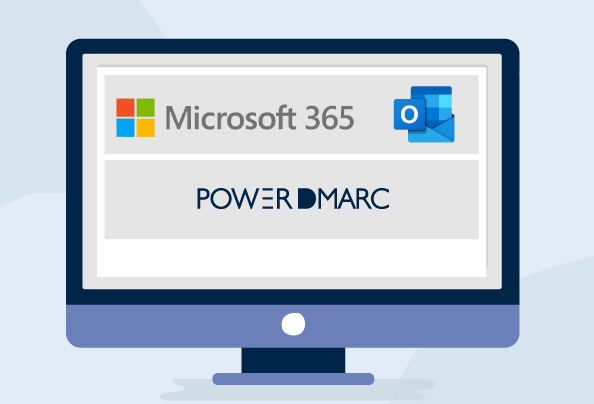Summary
Even if you’re using Microsoft Office 365 or Outlook, you need a DMARC provider for:
- Outbound email security
- Centralized visibility
- Expert management of email source
- Easy-to-read reporting
- Gradual and safe enforcement
- True domain protection across the board
Why Do You Need PowerDMARC’s DMARC Office 365 Setup?
1. Publishing a DMARC Record Isn’t the Finish Line
Publishing a DMARC record with a p=none policy and no RUA/RUF tags does not provide any actionable insight or enforcement. While technically valid, it offers no benefit in terms of security or visibility. The none policy does not enforce any action on spoofed emails that are failing DMARC, and without the RUA/RUF tags, you lack the visibility needed to find out who is sending emails on your behalf (legitimate and spoofing entities)
3. Gain Full Visibility into Your Email Ecosystem
To gain visibility and determine who is attempting to spoof your domain, PowerDMARC is needed. We process, analyze, and elegantly display your DMARC reports. Office 365 does not provide visibility on DMARC reports, which are generated as complex XML files sent to your inbox.
4. Identify Misconfigurations Early
In addition to identifying spoofing attempts on your domain, PowerDMARC provides visibility on misconfigurations for your DMARC Office 365-enabled emails, enabling you to ensure that all your senders are DMARC compliant.
5. Transition to Enforcement Safely
Changing your DMARC policy to p=reject without any visibility will prevent your legitimate emails from being delivered to your recipients, which will negatively impact your deliverability. Office 365 lacks visibility and reporting on DMARC, which PowerDMARC provides in a human-readable format.
FAQs
1. Does PowerDMARC integrate with Office 365?
Yes, PowerDMARC integrates with Office 365 seamlessly
2. How does it integrate with the administrative portal?
There is no need to integrate with the Microsoft 365 admin portal. You simply publish the DMARC record generated by PowerDMARC to your domain’s DNS through your DNS host (In this context, “FAR Cloud” appears to refer to a cloud-based DNS management or hosting service).
3. How are PowerDMARC’s offerings different from what Microsoft already provides?
Microsoft APT protects you against inbound phishing attacks, whereas PowerDMARC helps you implement DMARC to protect your domain from being spoofed/impersonated and fake emails being sent on your behalf to anyone. They both have different roles.
Microsoft does not provide the visibility, and publishing a DMARC record directly with an enforcement policy can cause issues in email deliverability. DMARC sends two types of reports, Aggregate and Forensic, which PowerDMARC represents in a detailed way so you can visualize if any legitimate source is rejected by the DMARC policy or malicious source needs to be rejected.
4. What is the value proposition?
Reducing the risk of anyone sending emails from your domains and gaining visibility on any malicious senders using your domain to scam others in your name.
Endnote
Using Microsoft Office 365 or Outlook does not mean you’re fully protected from email spoofing or domain impersonation. While Microsoft provides robust protection against inbound threats, the responsibility for outbound domain protection through DMARC lies entirely with the domain owner, including implementation, monitoring, and policy enforcement. A DMARC provider like PowerDMARC adds the missing layer of visibility, control, and security — helping you not only monitor but actively defend your domain from unauthorized use.
If you’re serious about securing your email domain, improving deliverability, and gaining actionable insights into your authentication posture, PowerDMARC is the perfect complement to your Office 365 environment. Start your free trial today or contact us to learn more!
